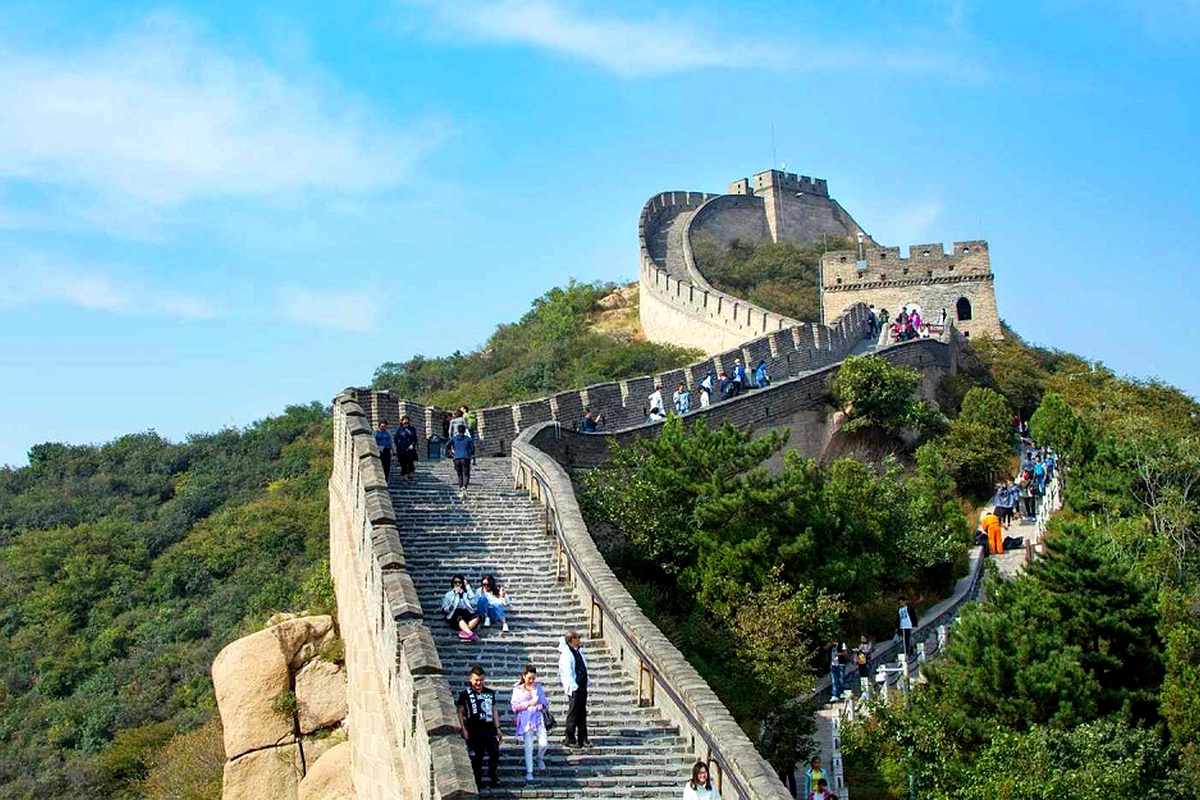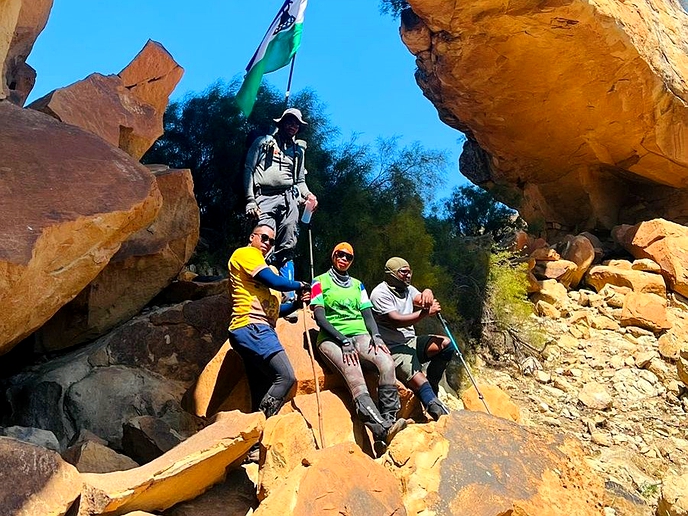BEIJING – THERE is a famous Chinese maxim that says, Heroes overcome, like Mao reaching the Great Wall. The saying is at times translated to mean, “He who doesn’t reach the Great Wall of China is no hero.”
travel
Nov. 1, 2023
BY LEBOELA MOTOPI
7 min read
Adventures of scaling the Great Wall of China

The Great Wall of China in Beijing
Story highlights
This is actually a popular and original line from a poem by the founder of the People's Republic of China, Chairman Mao Zedong.
The poem essentially discusses achieving one's objectives and overcoming obstacles in the process.
That is precisely how I felt when I arrived at the highest point of the publicly accessible part of the Great Wall in September.
The clear and brilliant sky of that chilly morning held the promise of a few sporadic showers later in the day.
With much enthusiasm, our group of reporters from various African countries who had come to China for a three-week media training session started its ascent.
A total of 34 media practitioners, including newspaper, radio, and television reporters as well as presenters, participated in the training that was organised by the China Radio and Television (CRTV) and commissioned by the Chinese Ministry of Commerce.
The programme was largely on the general situation of radio and TV in China, the cooperation between China and developing countries in the media industry, and the introduction to new media, including audio-visual language, multimedia information, editing, new media information planning, news writing, and interviewing, among other topics.
Participants were drawn from Lesotho, Zimbabwe, South Sudan, Ethiopia, Sierra Leone, Cameroon, Ghana, and Nigeria.
After days of feasting on Chinese food, we were all looking forward to free beverages and a buffet of quality western food, which the workshop organisers had promised to treat us to after we finished the climb in a set amount of time.
But the majority of us saw very quickly that it would not be an easy achievement to accomplish as soon as we began climbing the 2,700-year-old, 21,168.18-km-long wall.
There were numerous other travellers from all over the world who were eager to finish the climb before the sun got too hot or the rain disrupted the tour.
While some chose to climb in groups for moral support, the majority of people established their own paces and began their ascents alone.
A middle-aged Israeli couple, who claimed to be climbing the wall for the third time, encouraged one another to continue, with the wife gripping her husband's hand as if her life depended on it.
Several young tourists dashed through the wall’s watchtowers and quickly made their way back to the base of the wall for a well-earned nap.
The going quickly proved to be too difficult for a few of us who were not in good shape, so most of us fell behind. Others in our group gave up entirely and just took pictures and enjoyed the stunning scenery from both sides of the wall.
Prior to commencing the ascent, a tour guide who never bothered to climb the structure told us that the Great Wall largely contributed to China's rich literary culture in addition to acting as a military defence system.
The guide, who spoke through an interpreter because his English was not very good, gave a brief history of the thousand-mile wall, explaining that it is a massive structure made up of fortifications that were erected across the historical northern borders of imperial China to fend off foreign invasions.
According to him, a great number of walls date back to the seventh century BC, and many more were added later by succeeding dynasties.
He said that the Ming Dynasty built the most well-known portions of the wall between 1368 and 1444.
History also reveals that the Great Wall served other goals besides defence, including border control, enabling the application of tariffs on products moved over the Silk Road, promoting trade, and managing immigration and emigration.
Moreover, the defensive features of the Great Wall were reinforced by the erection of watchtowers, troop barracks, garrison stations, smoke or fire signalling capabilities, and the fact that the wall's route functioned as a transportation corridor.
History also demonstrates the many courses of the boundary walls constructed by several kingdoms.
Together, they form an arc that roughly marks the limit of the Mongolian steppe, extending from Liaodong in the east to Lop Lake in the west and from the Sino-Russian border in the north to the Tao River in the south.
As one of the greatest architectural achievements in history and one of the world's wonders, the wall is essentially acknowledged as such today.
Chinese characters, dates, and the names of past visitors to the historic site are etched on the majority of the stone walls.
Some of us, including my compatriot from Lesotho, Thuseho Leemisa of Lesotho Times, eventually made it to the top of the publicly accessible part of the wall after an arduous but rewarding climb.
I had a brief conversation with a Chinese visitor named Sam Xi as we slowly ascended, and he told me that the Great Wall represents perfection and fortune to him.
"Consider how patient our forefathers must have been to build this enormous structure; it required a great deal of effort, commitment, and sacrifice on the part of the Chinese people to finish the project."
Xi said that in order to be motivated to work more, he visits the Great Wall annually.
He remarked: "Coming here and scaling these walls reminds me that anything is possible with patience and hard work."
The subsequent descent was particularly hard on our knees because of the light drizzle that fell as we went downhill, making parts of the paved pathways and steps slick. According to accounts from international media, the four sections of the wall that are now accessible to the public are crowded on weekends and holidays.
The reports further show that some visitors reportedly climbed the walls of the blocked areas, causing structural damage.

Enjoy our daily newsletter from today
Access exclusive newsletters, along with previews of new media releases.
According to additional reports, Beijing's municipal government plans to expand additional locations in the northern suburbs of the city.
China recently revealed the findings of a state assessment, which revealed that the Great Wall is significantly longer than initially thought.
The study, which was published on Xinhua, states that the wall is 21,196.18 km (13,170.70 miles) long, as opposed to the 8,850 km estimate provided by a 2009 study.
The Great Wall, the biggest man-made structure in the world, stretches more than 20,000 kilometres from the Yellow Sea in the east to the Gobi Desert in the west.
It is known worldwide and influences many people's travel plans to China.
The wall is said to be seven metres wide and six to 14 metres tall, with over 25, 000 battlements that wind through dense forests and perilous mountain ridges.
Some days later, we took a high-speed train from Beijing, where the main training was held, to Danfeng County as a diversion from the busy workshop schedule.
Dafeng is located in the southeast of Shaanxi Province, at the southern base of the eastern Qinling Mountains.
It is the famous “hometown of walnut’ and the Danfeng wine, which inherits the oriental charm and absorbs the essence of the great Qinling Mountains.
High-speed trains, also known as bullet trains, are amazingly safe but can reach a top speed of 350 km/h.
Over 2, 800 pairs of bullet trains numbered G, D, or C run daily, connecting over 550 cities in China and covering 33 of the country's 34 provinces.
When we arrived in Danfeng, we took a bus to Taiping, the home village of the award-winning Chinese writer and poet, Chen Cang.
Watching the fields full of corn as we drove by made me realise how important corn really is to most people’s diets across the globe.
The long drive up the Qinling Mountains took us through a well-wooded countryside, keeping us on the edge of our seats, but the adept bus driver comfortably meandered the slopes and hairpin curves.
Later, when we arrived in Taiping, we were cordially welcomed by the residents and shared the famous walnuts and green Chinese tea with the famous author and his kinsmen.






